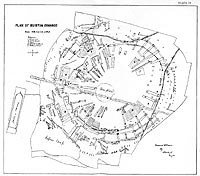Crannog
Irish Gaelic; 'crannag' Scots Gaelic
|
crannag, -aig, -an, s.f. Pulpit. 2 Round top of a mast. 3 Cross-trees of a ship. 4 Hamper. 5 Fillet used of old in dressing a woman's hair, snood. 6 * Churn. 7 Bar, in law. 8‡‡ Mill-clapper. 9‡‡ Hollow of a shield. 10 Kind of wicker or wooden frame suspended over the fire, on which fir-roots used for candles are set to dry. 11(AH) Fortified island in a lake, partly natural and partly artificial. [An ancient artificial islet on Loch Tollie, Poolewe, is called A' Chrannag.] 12 Applied to many kinds of wooden structures in Gaeldom. 13 Boat. C. air a stiùradh leis a'gbaoith, a boat steered by the wind. [The 'AH' in the entry refers to Alex Henderson, Ardnamurchan, Dwelly's source.] |
Definition
ON RIGHT IS THE FULL ENTRY for 'crannag' from Edward Dwelly's The illustrated Gaelic-English Dictionary, first published in 1901 (Fifth ed 1949; Alex Maclaren & Sons, Glasgow).
It's short and to the point.
It neatly defines the ancient artificial islands long known in Scotland and Ireland, thanks to 19th-century excavations of the man-made structures which had emerged from drained lochs. These fitted in with illustrations of inhabited islands on early maps, and even with the rough-and-ready techniques of the times, revealed finds from pre-Roman Iron Age times, through to the early medieval era.
That crannogs — whatever the individual dates — were not rare monuments in Scotland was then revealed by the unstoppable Reverend Odo Blundell, who in the years before the first World War, produced a corpus of around three hundred possible crannogs the length and breadth of the country. The energetic abbot of the Benedictine Priory near Inverness, he went so far as to do a hard-hat dive to confirm the underwater structure of a crannog in Loch Ness.
There the matter rested for several generations, with a few more up-to-date excavations: 1942, 1953 (Milton Loch I) and 1960 revealing substantial wooden frames or bases and house floors in three Highland and Lowland crannogs to confirm earlier work.
Crannogs? What crannogs?
 Robert Munro's plan of Buiston Crannog, with its mortised radial timbers, drawn in 1881. Later archaeologists not trained in underwater methods considered crannogs as quite rare monuments |
But by the 1960s real scepticism had crept into the archaeological establishment. Despite the growth of free-diving systems and sub-aqua clubs after World War II, no reputable archaeologists had dipped a toe in the freshwater lochs of Scotland. What was visible from the shore was a variety of heaps of stones, many overgrown with grass or trees, hardly different to the eye from entirely natural glacial mounds on dry land. That there could be a large unstudied group of monuments in the lochs, was surely improbable, when the landscape already had a convincing settlement pattern of duns and brochs and forts. Where were crannogs (presumably houses or defended sites) going to 'fit in'?
The unknown depths
The Royal Commission on Ancient and Historical Monuments' county survey of Lorn, published not long before the Loch Awe dives, considered all the Lorn (Argyll) specimens reported so far as 'dubious'.
No-one, in real life, was even prepared to get a boat and a glass-bottomed bucket to peer down into the water and check what was there. Why? Hard to understand today, when underwater methods have graduated into mainline archaeology, but at the time there was a dismissive attitude, maybe caused by the 'rip-it-out' treasure seeking that was, however, beginning to change in marine archaeology.
The difficulties underwater, to non-divers, appeared self-evidently insurmountable, despite the attraction of spectacular preservation of waterlogged material. Accurate excavation underwater looked impossible, compared with established dry-land methods.
So, whilst the existence of crannogs on a small scale was conceded, Blundell's estimate of numbers was put down to his obvious over-enthusiasm.
Back to front page